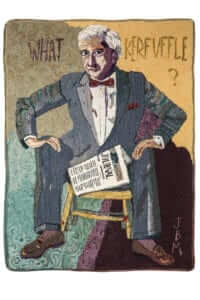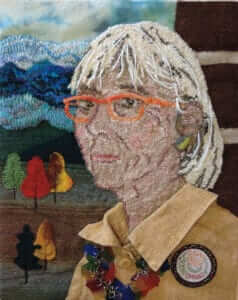Using humble tools and a simple technique, rug hookers make intricate works of art.
June Myles loves the way men look. When she comes across a man she finds especially attractive, Myles will spend hours poring over his features. She pays special attention to his nose—noses are complicated. Hair is even more complicated, so Myles often makes her men wear hats so she doesn’t have to deal with it.
She finds her men everywhere. She came across one in a Great Depression-era photo. Another time, she found a man in a book of Persian miniatures she picked up after seeing an exhibit at the Metropolitan Museum of Art. She’s found a few men in the obituary section of The Economist—she’s particularly fond of the Indiana Jones look-alike who was survived by a pet turtle he’d owned since he was a boy.

Myles, who splits her time between Elkins and Redding, Connecticut, developed her love of art as a child—she took art classes at the YMCA in Elkins when she was in elementary school. She tried many different art forms through the years, from pottery to painting to woodworking, but nothing really stuck until the late 1980s, when she took a class in rug hooking. “I got hooked,” she says. Although she does not sell her rugs, Myles’ work has been featured in shows all over New England.
The art and craft of rug hooking originated in the mid-1800s in New England and eastern Canada. It hasn’t changed much since then. Rug hookers start with a loosely woven “host” fabric and jab a metal hook through it, wrapping the shaft of the hook with a linguine-sized strip of fabric. This strip of fabric forms a small loop when the hook is pulled back through the host fabric. The hooker then repeats this process over and over, creating thousands upon thousands of small loops for one rug.
It’s a simple process, but one that allows rug hookers to make designs as complicated and detailed as they desire. “It’s an art form. Whatever artistic skills you want to accumulate will push through,” says Susan Feller, another well-known West Virginia rug hooker, located in Augusta. “I’ve been able to pull my art background and history into appreciating the traditional crafts.”
Feller also discovered rug hooking after dabbling in other art forms. She studied photography in college but that wasn’t tactile enough, so she tried oil painting and watercolors. It wasn’t until 1994, when she was running a framing shop and art gallery in New Jersey, that Feller found the art form that best suited her restless fingers. A customer took an antique rug in to be framed. Feller knew the customer made rugs of her own and asked for a tutorial. “She gave me the 15-minute lesson, which was all I wanted to have.” That brief introduction was enough to set Feller off on an artistic path that has consumed the past two decades of her life.
It wasn’t long before she tried making her own patterns, which she eventually started selling to fellow rug hookers through her business, Ruckman Mill 
Then, a few years ago, Feller sold her business to Green Mountain Hooked Rugs and became a student again. “My 59th year, I decided to knuckle down and figure out what I was doing with my art life. I could not afford a master’s degree so I decided, well, I could create my own independent study,” she says.
Nearly every day leading up to her 60th birthday, Feller made a small 5-inch square of artwork to experiment with different themes and concepts. Some were just sketches. Others combined rug hooking with jewelry work, quilting, embroidery, or painting. She exhibited the pieces as a full collection titled “The Year Study” in 2015. They’re now featured on her website, artwools.com, where the pieces are available for sale.
Feller is just glad artforms like rug hooking, embroidery, and quilting are finally getting the respect they deserve from the fine arts community. “When I was growing up, they were craft. Now I can use those techniques in an artistic way.” artwools.com











Leave a Reply